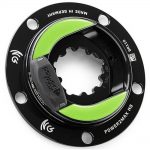Power meters allow you to see your power and cadence data in real time on your handlebar mounted bicycle computer, watch or smartphone (aka “head unit”). Data is transmitted wirelessly by the power meter to the head unit using a wireless transmission protocol. Power meter manufacturers have two wireless protocols to choose from when designing a power meter: ANT+ vs Bluetooth SMART. Traditionally, ANT+ power meters dominated the market and Bluetooth-equipped units were few and far between. However, with the recent rise in popularity of Bluetooth technology, more and more manufacturers are equipping their power meters with Bluetooth SMART functionality. So, if you’re in the market for a Bluetooth power meter, you have plenty of options.
In fact, we are now at the point where most power meters transmit data via both wireless transmission protocols, providing for maximum convenience. Below, we talk about ANT+ vs Bluetooth SMART, as well as show which manufacturers are currently using each technology.
ANT+ Power Meter
Let’s first start with ANT. ANT is an ultra-low power, 2.4 GHz wireless network. Its main purpose is to send standard information wirelessly from one device to another. However, there is an important distinction between ANT vs ANT+. ANT serves two functions. It determines how networks can be formed and also how data can be sent. It does not however establish what information may be included within the data that is sent.
ANT+ stands for interoperability and defines how the data and information is converted and sent – and makes sure it’s sent in a standardized way. Therefore, ANT+ allows two wireless devices to understand and communicate with one another, even if they are from different manufacturers. In the case of power meters, ANT+ allows your power meter to communicate with your head unit. Almost all power meters and head units use ANT+. (Polar is an exception as their devices only use Bluetooth.)
Advantages
- It’s an open system. An ANT+ power meter can send information to multiple head units simultaneously
- It’s efficient. Although both Bluetooth SMART and ANT+ require very little power, ANT+ really prides itself on its efficiency
Disadvantages
- There really isn’t any for the purposes we are discussing here (power meters and head units). While it isn’t as fast as Bluetooth SMART, as you will see below, it’s plenty fast enough
Bluetooth Power Meter
Bluetooth SMART, also known as Bluetooth Low Energy, Bluetooth 4.0 or BLE as its perhaps most often called, is also a wireless technology that allows information to pass between electronic devices. BLE allows devices to wirelessly connect with applications via smart phones and tablets. While Bluetooth is probably the more well-known of the two wireless protocols, until recently, there were only a handful of manufacturers on the market offering a Bluetooth power meter. Now, as you can see below, the majority of the market consists of Bluetooth equipped devices. Also, it’s important to note that when comparing ANT+ vs Bluetooth, the power meters capable of transmitting data via Bluetooth SMART can also send data via ANT+. So if your power meter has Bluetooth functionality, you have the option of transmitting data using either wireless protocol.
Advantages
- Allows devices to wirelessly connect with applications via smart phones and tablets
- It’s intuitive. Pairing a Bluetooth head unit or smart phone with a power meter is quick and simple
- A Bluetooth power meter can transmit information 64x per second, 16x faster than ANT+*
Disadvantages
- The sending and receiving devices must be linked and it’s therefore considered a “closed system”. With ANT+ for example, you can send data to multiple head units. With Bluetooth, you can only send data to one device
- We have found that certain Bluetooth SMART power meters don’t work well with certain head units. This has been documented by others as well. Sometimes power data will be sent to the head unit, but not other metrics such as left/right power balance. Other times, the two devices won’t communicate at all (more on this below).
*While ANT+ can transmit data 4x per second, and Bluetooth SMART 64x per second, current power meters aren’t running this fast. Why? It would be too hard on the battery. Most power meters record data closer to once per second. This way, the head unit can essentially enter sleep mode for very brief periods of time, thus prolonging battery life.
ANT+ vs Bluetooth Power Meter: Key Takeaways
The primary advantage to ANT+ is it works. As indicated above, certain head units have trouble communicating with certain power meters over the BLE wireless protocol. We think this will work itself out over time (as engineers continue to figure things out). However for now, we typically advise customers to use the ANT+ protocol whenever possible.
Another, lesser advantage to ANT+ is its open system nature. While both an ANT+ or BLE head unit can communicate with several devices at once (a power meter, heart rate monitor, etc.), an ANT+ power meter can communicate with several ANT+ head units at once, whereas a Bluetooth power meter can only communicate with one BLE head unit at a time.
The primary advantage to BLE is its ability to communicate with smart phones and tablets. This allows you to use your smart phone as a head unit (you just need to download a third-party cycling app). Most manufacturers that make a Bluetooth equipped power meter, also offer a power meter app, and these apps can make using a power meter easier and more rewarding. In addition, BLE compatibility allows you to connect with third party training platforms like Zwift.
One More Thing…Dual-Sided Systems
There is one more thing to mention – and that is the way these two wireless transmission protocols operate in a dual-sided power meter. A dual-sided power meter is one that has two power sensors, allowing it to measure left and right leg power independently. (Examples are the Favero Assioma DUO, Garmin Rally and ROTOR 2INpower DM power meters.)
With an ANT+ power meter, the left and right power sensors are connected to each other in a master/slave relationship. The power sensor that serves as the master, typically the left power sensor in most cases, connects to both the bicycle computer as well as the slave power sensor. The master sensor collects data from the slave sensor and communicates with the bicycle computer. The slave sensor only communicates with the master sensor – never with the bicycle computer directly.
With a Bluetooth power meter, each power sensor is paired individually and directly to the bicycle computer. The bicycle computer combines the power values from both power sensors in order to determine total power. This doesn’t have a direct effect on how you use or train with the power meter, but we think it’s always nice to understand how the equipment you are using is actually working.

 SRAM Force AXS Power Meter Crank Arm
SRAM Force AXS Power Meter Crank Arm  power2max NGeco SRAM Road Power Meter
power2max NGeco SRAM Road Power Meter  Stages Shimano XT M8100/8120 Power Meter
Stages Shimano XT M8100/8120 Power Meter 



I have asioma duo pedals. In the previous two years, I didn’t have any problems until recently. Since a week ago, I have problems with the connection to the main device (Wahoo elemnt bolt 2). The problem is that the pedals are connected to the device and after 20 seconds they disconnect and then connect again by themselves and they do it constantly. The other sensors work normally and I don’t have any problems with the connection on the other sensors(Speed, HR,Kickr core).
What could I do about that problem?
All updates have been done on my applications and devices. I have also tried to delete the applications from the phone and install them again and there is no progress. and i dont know what to do next …
Hi Igor. Please reach out to our support team via email at [email protected] or you can live chat with us when we are online for additional support. Our team can help walk you through additional troubleshooting steps and help solve this issue!
Is it possible to connect a single power meter to both Polar watch and Garmin bike computer?
Many thank,
Gerrit
Hi Gerrit. While you can pair your power meter to multiple devices for different uses, power meters can only communicate with one device at a time. We recommend pairing your power meter to a single device that would be best for your activity.
If I’m pedalling at a higher cadence in a lower gear at the same speed as someone riding beside me is my power output the same as theirs? They had a power meter and said it was but I thought using lower gears and higher cadence required less power.
Hi Clayton. Power numbers are determined by many different factors. First and foremost, two different cyclists riding side by side will have a different power output depending on things like weight, bike set-up, aerodynamic profile, etc. You can’t really compare power numbers like that. Regarding gearing, if you are riding in a lower gear but spinning faster, this produces similar power to riding in a higher gear but spinning slower – so your statement about lower gears isn’t really true in that aspect. I hope this helps! Thank you!
If I can only use the BLE, since I have a Polar Vantage V. Can I use a dual sided power meter, or would it just send one signal? Just trying to figure out if I just need a single sided power meter. Thanks!
Hi Henrik. Actually, you can run a single- or dual-sided power meter with your Polar. The way a BLE device like a Polar talks to and pairs with a power meter is a bit different than with an ANT+ device, but you still have your choice of power meter.
Find this really useful and interesting information.
Do you know if there’s a way to simultaneously connected 2 powermeters to the same device (bike computer, watch, laptop etc) and gather data from both? Similar, in a way, to connecting the left and right pedals but instead not pairing the 2 powermeters with each other, pairing them individually to the device.
Thanks
Rory
Hi Rory. You would need a separate head unit for each power meter. Thanks!
Any advantage of of ANT+ vs BT in terms of connection reliability between the power meter and head unit (in my case a Stages Left Side only and Garmin 920XT)? I am having problems with consistent readings while using my 920XT mounted on my wrist and wondering if switching to BT might help..
Hi Matt. Actually, we have found that the ANT+ protocol is usually stronger and less problematic. Unless you specifically need BLE to communicate with a device, we suggest ANT+. Is your Stages a Gen. 2 by chance? Those units had somewhat weak transmitters and can experience signal drops. Their Gen. 3 units fix that.
i was wondering about a direct drive trainer like Wahoo Kicker or Elite Drecto are these accurate for power and heart rate readings? Do you have any information on this?
Thank you,
Judi
Hi Judi. Yes, “smart trainers” typically do a good job of calculating power. Most of them read within about 2%, which is on par with most power meters. We like the CycleOps trainers and currently sell them on our site. Regarding heart rate, that will always come from a separate heart rate strap.